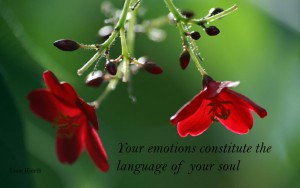It was when I participated in courses about ‘Horse Facilitated Learning’ that I came across knowledge about the part emotions play when we are in contact with horses. I participated in practical HFL courses but I also included the topic in my university psychology studies.
I read about research conducted by Paul Ekman, Richard J. Davidson, Daniel J. Siegel, but especially research performed by Peter A. Levine and Jaak Panksepp made a big impression on me. I also read Karla McLaren’s book ‘The Language of Emotions’, which gives a new and very interesting perspective on emotions. But every time I read about research on emotions, I felt that a dimension was missing. I started writing my own book about the subject and after four years I felt that I had got a good grip on my own understanding of the subject. However, I gave up that version of the book and started writing a new version, which was published in Denmark in May 2016.
When I consider my own perspective to be different to that of others, it is primarily due to my sensitivity (LINK). When I discover emotions in me or in others, I don’t understand them – I feel them. It is from this perspective that I have written my book about emotions. It may sound simple, but consider this, and you will see how often we talk and think about emotions, and not about how the emotion feels. We feel emotions in the body and think thoughts in the head.
Emotional energy can be described as a bodily anchored emotional states or conditions, which are completely individual from person to person. Every single person has countless numbers of these states, and they come and go from moment to moment. The states have basic patterns, which allow us to relate to other people’s states. We give emotions names like sorrow, grief, anger etc. but every emotion exists in its own form. It’s like the colour blue when it is expressed in the word blue, but everywhere there is anything blue this blue colour exists in its own existence. It is the same with emotions. We can talk about sorrow, but the emotional energy of sorrow in every person exists in its own form of energy.
This is important if we want to understand and develop our emotions. We usually talk about emotions, when we want to understand the challenges they give us. But for a start, emotions must be felt. When we have felt them, we can start to talk about them and understand them. We can talk as much as we want about sorrow, but it’s not until we have felt the energy from sorrow, the emotion will be transformed in our body to a new energetic state. This is where the emotion is ‘felt to the end’ or is being ‘finally transformed’ as I like to put it.
An emotion is energy, but it is also a biological tool that we have gained and developed through evolution. Emotional energy gives us the possibility to thrive in social contexts, it helps us survive and it helps us maneuver in the situations we find ourselves in. They guide us towards what we need and away from what we don’t need. They are great helpers, which we often give much too little credit.
This description of what emotions are, why we have them, where we use them and how to develop them can be found in my book about emotions. It is a different perspective but a practical perspective which can be transferred into daily life experiences. It is also an opening to a spiritual understanding of life. When we start to open up for the energetic understanding of emotions, we open up for the possibility of understanding energies in general. It then becomes possible to understand humans as energetic bodies with a soul and spirit. This can lead us to understanding how we all are connected and how we all communicate with our active energies at all times.
The understanding of emotions is my own soul’s purpose. All animals are very dear to me, and my biggest goal in life is to teach humans about what animals have to offer. To be able to apply this knowledge and wisdom, humans must understand the language of animals, and this language is emotional energy.

